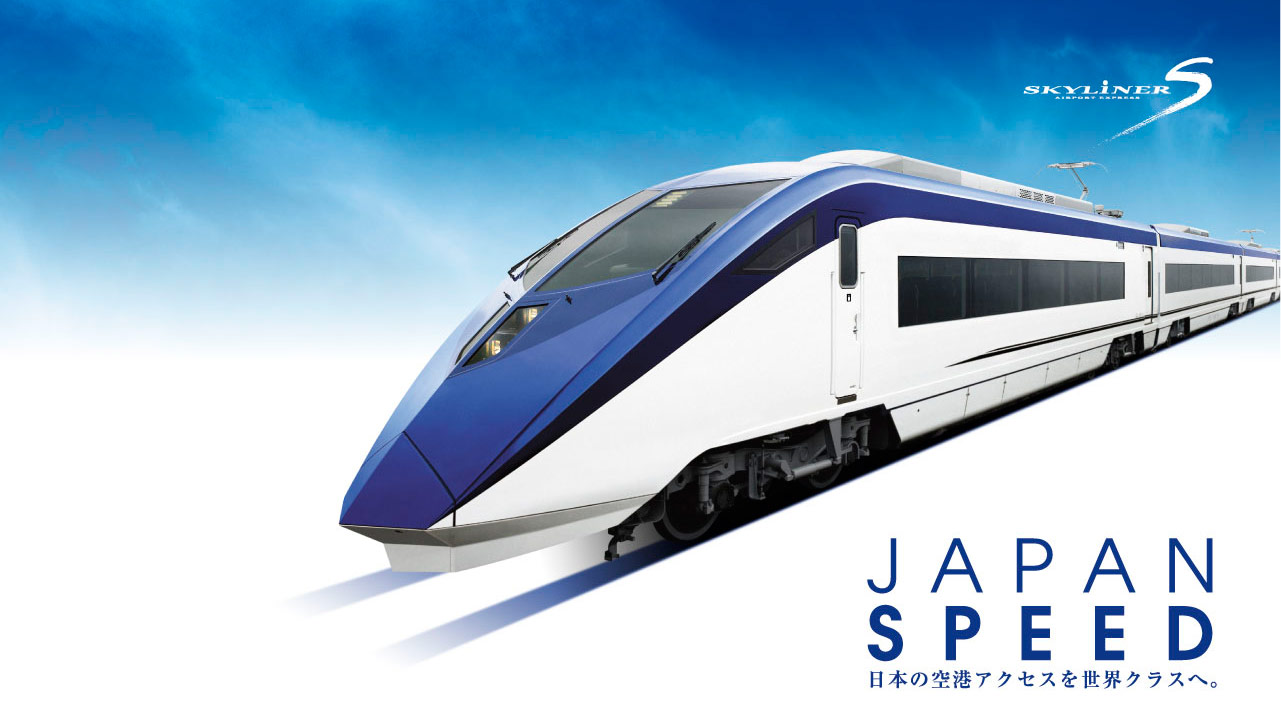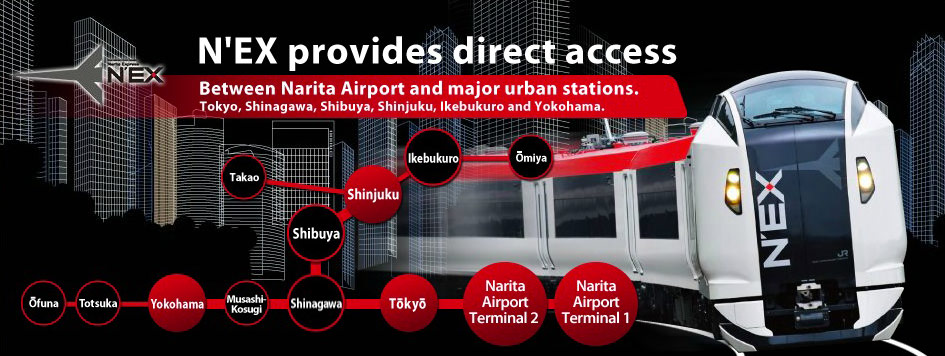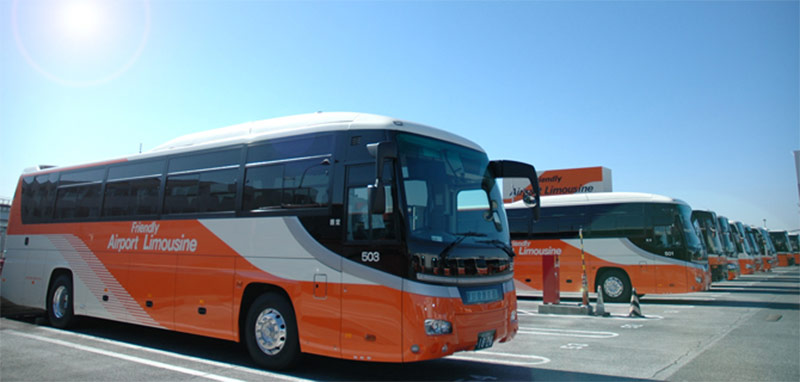From Narita Airport to Downtown Tokyo
Most of the foreign travelers in Japan, coming from the western part of the world, land at Narita International Airport and mainly want to reach their accommodation in Tokyo. However, the landing happens, in this case, more than 60 kilometers away on the eastern side of the Japanese capital city, in Chiba prefecture.
Since transportation in Japan is not always the easiest thing to handle, especially for Japan first time travelers, and because questions about this topic come back regularly, this article will give you details about duration and costs of this transportation, accordingly to the different means and arrival train 🚅 stations.
General guidelines
This guide is based mostly on transportation with train and subway 🚇, as well as some buses. Indeed, there are other means of transportation, more private (such as taxi, rental car 🚙 and helicopter 🚁!) but those remain a lot less used, belonging to a higher-end budget and also not being as convenient as trains. As a little anecdote, you can count about:
- ¥16 to 27,000 (~US$102.21 to ~US$172.50) and at least 1,5 hour by taxi.
- From ¥45,000 (~US$287.50) and 15 minutes by helicopter + limousine car.
Consequently we won’t spend time on it.
Overall, the Keisei Skyliner is faster but more expensive than the Narita Express, which is itself faster than the bus.
All transportation presented in this article are accessible from both Terminal 1 and 2 of the airport. If you have a changing and/or a little walking to do to reach your accommodation, we recommend the use of takkyûbin (luggage delivery).
Be careful: in the evening and mostly at night, there are a few or no transportation at all departing from Narita airport. Check carefully the compatibility of your landing/take-off hours with the transportation means described below. There are several hotels 🏨 located nearby the terminals where to spend the night while waiting for the first morning trains.
Finally, let us precise some vocabulary here: we talk about Tokyo as being the capital of Japan, but it is also the name of train station just like any other, located South-East of the city center.
Operating hours and fares
You can help yourself with a currency converter in order to know the prices in dollars or other currencies depending on the current exchange rate. All prices indicated on this article are for one adult in ordinary class. Overall, you can divide the cost by two for a child (from 6 to 11 years old in general) and multiply it by two for the Green car (equivalent to the first class).
Only transportation operated by the JR company are compatible with the Japan Rail Pass and therefore are covered and free when using it (if it is activated of course). For other travelers, an individual ticket must be purchased in advance, but we do recommend the use of a Suica card for more convenience.
Travel times to each train station below are given from Narita airport Terminal 1, the farthest one from Tokyo. You can count two to three minutes between the two terminals.
Please note that in case of a change of train, you need to add the transfer duration which varies according to:
- The trains' schedule (depending on the time of the day, to be checked on Hyperdia or Navitime for example);
- Your walking pace and rapidity to get to the different platforms.
Keisei Skyliner

The Skyliner, operating since 2010, happens to be the fastest mean to reach downtown Tokyo (36 minutes to Nippori) but it remains a little more expensive than JR trains (beside N’EX). Seat reservation is required before boarding the Keisei Skyliner.
- Timetable (departures every 20 to 40 minutes on average);
- Basic fare: ¥2,570 (~US$16.42);
- Fare when booking in advance from their website (up to 3 weeks before the requested day): ¥2,300 (~US$14.69);
- Free wifi in the train since April 2015.
Alternatively, there is also the "Keisei Main" line, going from Narita to Nippori or Ueno for half the price but much more slower.
JR Narita Express (or N’EX)

All Narita Express trains go through Tokyo station. Some do stop by it, but most of them divide into two: one part goes towards Ikebukuro and stop by the capital's western and northern stations, and the other part goes to the South up to Yokohama. Warning: even if you are holding a valid JR Pass, you will need to book a seat (for free in this case) before boarding the N’EX train.
- Timetables (departures every 30 minutes to 60 minutes, from around 6:30 a. m. to 8:45 p.m.)
- Basic fare: from ¥3,070 to ¥4,700 one way (~US$19.61 to ~US$30.03) , depending on the destination in the greater Tokyo.
For non-Japanese passports’ holders (to show at the ticket counter): the round-trip to Tokyo costs ¥4,070 (~US$26.00) instead of ¥6,140 (~US$39.22) minimum, for a duration stay up to 14 days maximum.
Buses

Buses are an interesting alternative because, in addition to stopping at Tokyo’s main train stations, they also stop at the doors of several dozens of hotels in the capital. On the other hand, they can obviously be slowed down by traffic, especially during rush hours. There are several departures per hour, for a duration of about 1h to 1h30.
Several bus companies operate Narita Airport.
Airport Bus "TYO-NRT" (formerly "The Access Narita" and "Keisei bus - Tokyo Shuttle" – online booking only in Japanese):
- Fee: ¥1,300 (~US$8.30) by day or ¥2,600 (~US$16.61) by night and early morning;
- Destinations: Ginza and Tokyo stations, Shinonome Shako and Aeon-mae;
- Toilets on board of most buses, broad seats.
Friendly Airport Limousine:
- Timetable and destinations (departures greatly vary depending on the destinations)
- Basic fare: from ¥2,800 to ¥3,800 (~US$17.89 to ~US$24.28)
- Round trip fare up to the center of Tokyo: ¥4,500 (~US$28.75)
From Narita to Tokyo’s trains stations
The stations are sorted in alphabetical order. For each of them, you will find different itineraries depending of your budget and how fast you want to reach the stations.
Akihabara
- JR Narita Express to Tokyo Station (¥3,070 / 53min), then JR Yamanote (¥160 / 7min)
- Keisei Skyliner to Nippori (¥2,570 / 36min), then JR Yamanote (¥160 / 7min)
- Keisei Main up to Ueno (¥1,050 / 80min), then JR Yamanote (¥140 / 4min)
Asakusa
- Keisei Sky Access Express (¥1,310 / 70min)
- JR Narita Express to Tokyo Station (¥ 3,070/ 53min), then JR Yamanote up to Kanda (¥140 / 2min), then Tokyo Metro Ginza line (¥170 / 5min)
- Limousine Bus (¥2,800 / 105~135min)
Ginza
- Keisei Sky Access Express to Higashi-Ginza (¥1,350 / 76min)
- Limousine Bus (¥3,100 / 95~130min)
Ikebukuro
- JR Narita Express to Shinjuku (¥3,250 / 80min), then JR Yamanote (¥170 / 5min)
- Keisei Skyliner up to Nippori (¥2,570 / 36min), then JR Yamanote (¥170 / 13min)
- Limousine Bus (¥3,100 / 105~140min)
Roppongi
- Keisei Skyliner up to Ueno (¥2,570 / 41min), then Tokyo Metro Hibiya (¥200 / 25min)
- Keisei Main Line up to Ueno (¥1,050 / 80min), then Tokyo Metro Hibiya (¥200 / 25min)
- Limousine Bus (¥3,100 / 90~140min)
Shibuya
- JR Narita Express (¥3,250 / 75min)
- Keisei Skyliner up to Nippori (¥2,570 / 36min), then JR Yamanote (¥200 / 29min)
- Limousine Bus (¥3,100 / 85~115min)
Shimbashi
- Keisei Skyliner up to Nippori (¥2,570 / 36min), then JR Yamanote (¥170 / 15min)
- Keisei Main Line up to Ueno (¥1,050 / 89min), then JR Yamanote (¥160 / 11min)
Shinagawa
- JR Narita Express (¥3,250 / 67min)
- Limousine Bus (¥3,100 / 75~105min)
Shinjuku
- JR Narita Express (¥3,250 / 80min)
- Keisei Skyliner up to Nippori (¥2,570 / 36min), then JR Yamanote (¥200 / 22min)
- Limousine Bus (¥3,100 / 85~115min)
Tokyo Station
- JR Narita Express (¥3,070 / 53min)
- Keisei Skyliner up to Nippori (¥2,570 / 36min), then JR Yamanote (¥160 / 11min)
- Keisei Main Line up to Ueno (¥1,050 / 80min), then JR Keihin-Tohoku Negishi Rapid (¥160 / 6min)
- Limousine Bus (¥3,100 / 85~110min)
Ueno
- Keisei Skyliner (¥2,570 / 41min)
- Keisei Main Line (¥1,050 / 80min)
- JR Narita Express up to Tokyo Station (¥3,070 / 53min), then JR Keihin-Tohoku Negishi Rapid (¥160 / 6min)
Yokohama
- JR Narita Express: ¥4,370 / 89min
- Limousine Bus (¥3,600 / 85~110min)
From Narita to Haneda : the inter-airports ride
This is a journey that can be necessary, specifically in the case of a connecting flight ✈️. The two international airports of Tokyo are separated by 80 kilometers at the shortest.
Here are the different main solutions linking these two:
- Keisei Sky Access Express (¥1,730 / 115 minutes)
- JR Narita Express to Shinagawa (¥3,250 / 67min), then Keikyu Main Airport Rapid Limited Express (¥410 / 16 minutes)
- Limousine Bus (¥3,200 / 75~100 minutes)
While waiting inside, Narita airport offers a "transit program" in order to enjoy the surroundings (temporarily suspended due to Covid 🦠).
From Narita to Mont Fuji
In summer 2014, a new connection for the Narita Express was tested between Narita Airport and Kawaguchiko at the foot of Mount Fuji 🗻. It was made possible thanks to two railway companies working together: East JR et Fujikyuko.
This special N’EX train commutes from July to September, only on Fridays, weekends and bank holidays. The travel lasts 3h30 and cost ¥7,000 (~US$44.72), with the following schedule:
- 9:15 a.m. - 12 :43 p.m. (from Narita to Kawaguchiko)
- 2:13 p.m. - 5 :41 p.m. for the way back (from Kawaguchiko to Narita)
It stops at Tokyo Station, Shibuya, Shinjuku, Tachikawa and Hachioji. This direct train helps make simpler a trip that normally requires two transfers.
Reservation is required to board this train, up to one month in advance, in one of the usual JR offices in Japan or on the JR East website: Ekinet (only in Japanese). The line’s operation is currently on hold due to the Covid pandemic.

